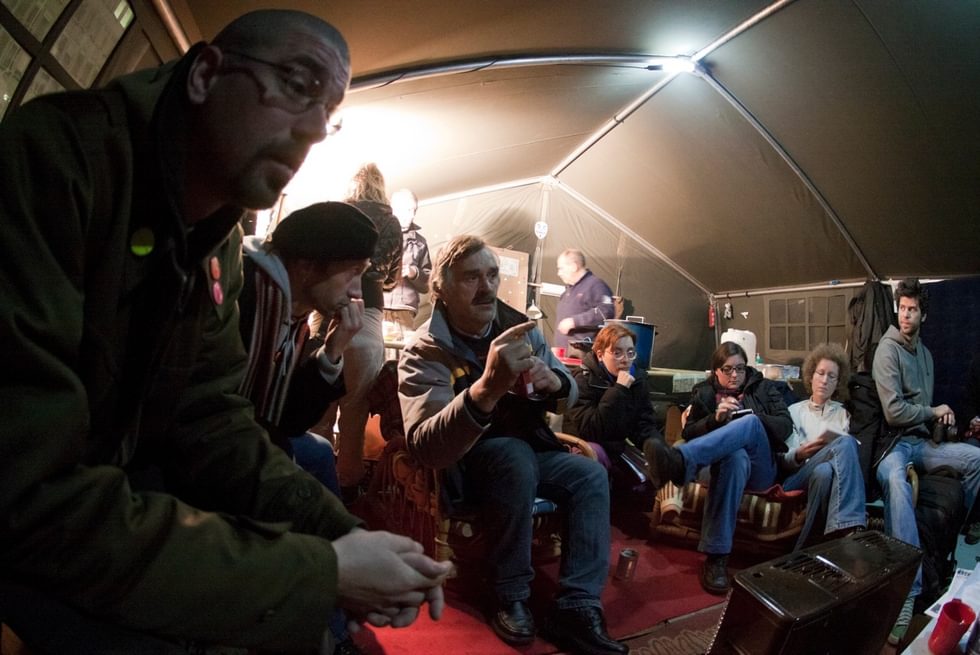Occupy Nova Scotia: The Symbolism and Politics of Space
From the Series: Occupy, Anthropology, and the 2011 Global Uprisings
From the Series: Occupy, Anthropology, and the 2011 Global Uprisings

On October 15, 2011, in response to the original AdBuster’s call-out to “Occupy Wall Street” and in solidarity with the occupations mushrooming throughout North America and around the world, Occupy Nova Scotia claimed a central piece of public space in downtown Halifax, Nova Scotia, Canada as its own. A mid-sized Maritime city on the periphery (geographically as well as economically and politically) of the Canadian state, Halifax is also one of the oldest colonial settlements in North America, a still-significant military port, and a regional hub (administrative, economic, political, and cultural) in a distinctly depressed region. Unlike the resource booms currently fuelling development in provinces like Alberta, British Columbia, Saskatchewan, and Newfoundland, Nova Scotia and its sister Maritime provinces have experienced economic stagnation, economically-driven outmigration, and narrowing horizons. Faced with these realities, aware of the historically-unprecedented transfer of public wealth into private hands that marked elite responses around the world to the latest convulsions of global capitalism, and staring at a whole new era of “austerity,” approximately 250 people gathered at the Grand Parade grounds in the heart of downtown Halifax on an extraordinarily beautiful fall day in order to manifest their dissent against the status quo, to collectively air their grievances, and to attempt to prefigure alternatives. Ultimately, the Occupy encampment in the heart of Halifax’s downtown core would be populated by around 50 occupiers.

With all the trappings common to other Occupy encampments—the People’s Mic [1], the establishment of a consensus-based assembly for the encampment, the provision of an infrastructure (tents, food, medical supplies, etc.) capable of supporting the occupiers for an indefinite period of time—the Occupy NS encampment began its life in a spirit of frivolity as much as resistance. Drumming circles, spoken word performances, chalk drawing, dancing, and the People’s Mic allowed a diverse group of occupiers to voice their grievances, aspirations, and motivations. In a series of impromptu interviews I conducted with those in attendance on the first day of the occupation, most participants were enthusiastic, but some had a much dimmer view of Occupy’s capacity to challenge and transform power relations at the level of everyday lived realities.

The location chosen for the Occupy encampment in Halifax was intended to be strategic. The Grand Parade—historic military parade grounds dating to the city’s founding in the mid-1700s—are directly outside of Halifax City Hall, adjacent to the World Trade and Convention Centre, and the Toronto-Dominion Waterhouse bank main offices. The Cenotaph—a large standing sculpture commemorating fallen Canadian soldiers in World War I—stands at the centre of the grounds and, ultimately, would provide a material focal point for Occupy NS’s most significant political challenge. While the rhetoric of municipal officials with respect to Occupy NS initially paid lip service to the spirit of civic engagement the occupiers supposedly represented, as the occupation wore on and Remembrance Day [2] drew nearer, the occupiers were increasingly drawn into a rhetorical dance with politicians and veterans about the ethics of their occupation given the significance of the Grand Parade for Remembrance Day services. In Halifax—a long time military town—the symbolic significance of this tension cannot be overstated.

As the occupiers dealt, on the one hand, with the day-to-day struggles of maintaining life at the camp—including learning to negotiate internal tensions and working to integrate members struggling with mental health and substance abuse issues—they also struggled publicly with the decision about whether or not to leave the Grand Parade. Ultimately, mobilizing language freighted with nationalism and militaristic patriotism, the occupiers declared they had reached a settlement with veterans and city officials. The Occupy NS camp would be temporarily relocated to another city park further west of the downtown core, the occupiers would take part in Remembrance Day memorial activities at Grand Parade, and the memorial activities would proceed as usual. On November 11, 2011, Remembrance Day, following the memorial ceremonies at the now vacated Grand Parade, Halifax Regional Police enacted a decision taken in secret by the city council to forcibly evict the transplanted Occupy NS encampment just hours after it had been established. While the occupiers and their supporters would make a day-long symbolic return to Grand Parade a week after the Remembrance Day eviction and publicly denounce the perceived duplicity of city officials and the violence of the Halifax police force, the occupation was officially over.
By way of conclusion, I would suggest there are lessons to be drawn from the Remembrance Day eviction and the events leading up to it. These relate to the importance of appreciating both the material and symbolic significance of space. For Occupy NS, city politicians, the police, and the broader public—supportive of the occupiers or not—the legitimacy and meaning of the occupation came to be interpreted through the lens of the space in which it occurred and the historical significance with which it is vested. Interestingly, the symbolic significance of Grand Parade and Remembrance Day ended up cutting both ways. On the one hand, Occupy NS was drawn, problematically to my mind and in some ways to their distinct disadvantage, into a rhetorical and gestural affirmation of the patriotic, nationalistic, and militaristic legacy embodied by Remembrance Day and the purposes it serves in the context of contemporary Canadian military adventurism. This not only diluted any radical critique of the status quo emanating from the camp, it also led ultimately to its violent eviction. On the other hand, given the widespread nationalist mythology that Canadian troops have always only fought and died for democracy, peace, and justice, when the mayor decided to use force to evict the occupiers on Remembrance Day in the midst of a rainstorm, public opinion turned significantly against the mayor and city council. This was only exacerbated by council’s tradition of holding important discussions and taking decisions in private and without official minutes, thus rendering the operation of municipal power completely opaque to the public.
Ultimately, the debacle of the eviction would not only contribute to Mayor Peter Kelly’s announcement that he would not seek re-election but would also generate a protracted public discussion about democracy and its practice in the city of Halifax. And yet, despite this opening, this too was in the final instance reduced in the public domain to a debate about the legality of urban camping, the use of off-the-record sessions at city council, and the latitude that ought to be afforded to protest, all rendered in a thoroughly liberal discourse. Context matters. The spaces within which struggle occurs, whether material or symbolic, shape the forms that struggle takes. At the risk of hyperbole, I would nevertheless suggest that the occupation in Halifax came itself to be occupied by the hegemonic discourse of the good liberal citizen wrapped in the patriotic symbolism of the war dead.
[1] The People’s Mic is a process whereby a speaker uses the crowd of listeners as the method of amplification in the absence of a sound system. When someone indicates they wish to address the crowd, calls of “Mic check! Mic check!” call for quiet and the help of listeners. Speakers will then speak a few words or a sentence, wait for the gathered listeners to repeat and amplify their voice, and then continue.
[2] Remembrance Day is a memorial day observed in Commonwealth countries since the end of World War I to commemorate members of national armed forces who were killed in war.
Alex Khasnabish is an Assistant Professor in the Department of Sociology and Anthropology at Mount Saint Vincent University. He is the author of Zapatistas: Rebellion from the Grassroots to the Global (Zed Press, 2010) and Zapatismo Beyond Borders: New Imaginations of Political Possibility (University of Toronto Press, 2008) as well as numerous articles on the radical imagination, social movements, globalization, and social change.